Analysis of Particle Number Emissions in a Retrofitted Heavy-Duty Spark Ignition Engine Powered by LPG
Abstract
:1. Introduction
2. Materials and Methods
3. Results and Discussion
3.1. Steady-State Conditions
3.2. Transient Conditions
4. Conclusions
- The PN emissions increased after TWC when the conditions of the steady-state modes included temperatures around 500 °C and exhaust gas flows lower than 120 kg/h (high residence time), facts that increased the formation of PN from UHC conversion and the division of particles with diameters between 500 nm and 1000 nm. Steady-state modes with temperatures around 600 °C and 700 °C and medium and high exhaust flows showed negligible differences in PN and a slight shift towards larger particles in PSD, both upstream and downstream of the TWC;
- It was observed that total PN, when measured in particles with diameters of 10 nm instead of 23 nm, increased by between 17.70% and 40.84%. Modes characterized by lower exhaust temperatures and mass flow rates exhibited the greatest increases;
- Transient states of the engine had an effect on PN emission, because these emissions increased due to variations in the engine power, and the most critical parts showed dynamic variations under quasi-steady state conditions. Additionally, the PN emissions were two times and three times higher than the current Euro VI limit (6 × 1011 #/kWh) when the particles measured sized 23 nm and 10 nm, respectively;
- The GMD analysis exhibited certain variations as a function of the engine load. However, its overall trend indicated relatively consistent emission levels, presenting an advantage for LPG owing to its inherent physical properties and the utilization of port fuel injection systems. In general, it is observed that the trend in GMD during dynamic engine conditions decreases from 50 nm to 30 nm when accounting for particle concentrations between 10 nm and 23 nm. This underscores a notable concentration of these particles, deemed the most hazardous due to their size, thus emphasizing the imperative for their regulation in forthcoming regulatory frameworks;
- Future research on the application of particulate filters should focus on evaluating the effects of these devices on particles sized between 10 nm and 23 nm, under both steady-state and transient conditions. This approach aims to determine whether current technologies are adequate for meeting forthcoming regulatory requirements, or if there is a need to develop new technologies. Furthermore, it is proposed that catalyzed particulate filters be analyzed in future studies to enable the integration of different technologies to meet future regulations while reducing the complexity of the aftertreatment system architecture.
Author Contributions
Funding
Institutional Review Board Statement
Informed Consent Statement
Data Availability Statement
Conflicts of Interest
Nomenclature
| ATS | aftertreatment systems |
| CNG | compressed natural gas |
| CO | carbon monoxide |
| CO2 | carbon dioxide |
| CS | catalyst stripper |
| CPC | condensation particle counters |
| EEPS | engine exhaust particle sizer |
| ET | evaporation tube |
| GMD | geometric mean diameter |
| GTR | global technical report |
| HD | heavy-duty |
| LPG | liquefied petroleum gas |
| NOx | nitrogen oxides |
| PMP | particle measurement program |
| PN | particle number |
| PN10 | particle number with diameters equal to or larger than 10 nm |
| PN23 | particle number with diameters equal to or larger than 23 nm |
| PTD | porous tube diluter |
| PSD | particle size distribution |
| RON | research octane number |
| Scharger | supercharger |
| SI | spark-ignition |
| TWC | three-way catalyst |
| UHC | unburned hydrocarbons |
| VPR | volatile particle remover |
| WHTC | world harmonized transient cycle |
References
- IEA (International Energy Agency). Key World Energy Statistics 2020. Int. Energy Agency 2020, 33, 4649. [Google Scholar]
- NOAA National Centers for Environmental Information. Monthly Report January 2024 Global Climate Report. Available online: https://www.ncei.noaa.gov/access/monitoring/monthly-report/global/202401 (accessed on 10 April 2024).
- Fuller, R.; Landrigan, P.J.; Balakrishnan, K.; Bathan, G.; Bose-O’Reilly, S.; Brauer, M.; Caravanos, J.; Chiles, T.; Cohen, A.; Corra, L.; et al. Pollution and Health: A Progress Update. Lancet Planet Health 2022, 6, e535–e547. [Google Scholar] [CrossRef]
- EEA Monograph Assessment and Management of Urban Air Quality in Europe. Available online: https://www.eea.europa.eu/publications/environmental_monograph_2006_5/file (accessed on 12 April 2024).
- Li, F.; Schnelle-Kreis, J.; Cyrys, J.; Karg, E.; Gu, J.; Abbaszade, G.; Orasche, J.; Peters, A.; Zimmermann, R. Organic Speciation of Ambient Quasi-Ultrafine Particulate Matter (PM0.36) in Augsburg, Germany: Seasonal Variability and Source Apportionment. Sci. Total Environ. 2018, 615, 828–837. [Google Scholar] [CrossRef]
- Li, D.D.; Wang, C.; Chan, Q.N.; Yeoh, G.H. Soot: A Review of Computational Models at Different Length Scales. Exp. Comput. Multiph. Flow 2023, 5, 1–14. [Google Scholar] [CrossRef]
- Zhou, L.; Zhang, X.; Yu, Y. Experimental and Numerical Studies on the Wall-Roughness Effect to Particle Dynamics in Various Gas-Particle Flows. Exp. Comput. Multiph. Flow 2023, 1, 1–8. [Google Scholar] [CrossRef]
- Climate Change Authority of Australian Government. International Implementation of Vehicle Emissions Standards. Available online: http://www.climatechangeauthority.gov.au/reviews/light-vehicle-emissions-standards-australia/international-implementation-vehicle-emissions (accessed on 8 April 2024).
- Catapano, F.; Di Iorio, S.; Sementa, P.; Vaglieco, B.M. Optimization of the Compressed Natural Gas Direct Injection in a Small Research Spark Ignition Engine. Int. J. Engine Res. 2017, 18, 118–130. [Google Scholar] [CrossRef]
- Payri, R.; Gimeno, J.; Marti-Aldaravi, P.; Mendoza Alvarez, V. Study of the Hydraulic Characteristics of Two Injectors Fed with Different Fuels in a GDI System. Fuel 2022, 317, 123196. [Google Scholar] [CrossRef]
- General Secretariat of the European Union Council Regulation (EU) 2024/1257. Available online: https://eur-lex.europa.eu/legal-content/EN/TXT/HTML/?uri=OJ:L_202401257 (accessed on 6 June 2024).
- Pastor, J.V.; Micó, C.; Lewiski, F.; Tejada, F.J.; Tornatore, C. A Synergic Application of High-Oxygenated E-Fuels and New Bowl Designs for Low Soot Emissions: An Optical Analysis. Appl. Sci. 2023, 13, 8560. [Google Scholar] [CrossRef]
- Milojević, S.; Glišović, J.; Savić, S.; Bošković, G.; Bukvić, M.; Stojanović, B. Particulate Matter Emission and Air Pollution Reduction by Applying Variable Systems in Tribologically Optimized Diesel Engines for Vehicles in Road Traffic. Atmosphere 2024, 15, 184. [Google Scholar] [CrossRef]
- Boger, T.; Rose, D.; He, S.; Joshi, A. Developments for Future EU7 Regulations and the Path to Zero Impact Emissions—A Catalyst Substrate and Filter Supplier’s Perspective. Transp. Eng. 2022, 10, 100129. [Google Scholar] [CrossRef]
- Lou, D.; Qi, B.; Zhang, Y.; Fang, L. Research on the Emission Characteristics of a Passenger Car Powered by Ethanol, Methanol, and Liquefied Petroleum Gas Under Real-World Running Conditions. J. Energy Resour. Technol. Trans. ASME 2023, 145, 042303. [Google Scholar] [CrossRef]
- Pastor, J.V.; García-Oliver, J.M.; Micó, C.; García-Carrero, A.A.; Gómez, A. Experimental Study of the Effect of Hydrotreated Vegetable Oil and Oxymethylene Ethers on Main Spray and Combustion Characteristics under Engine Combustion Network Spray A Conditions. Appl. Sci. 2020, 10, 5460. [Google Scholar] [CrossRef]
- Bermúdez, V.; Ruiz, S.; Sanchis, E.J.; Conde, B. Assessment of Exhaust Raw Emissions and Aftertreatment Performance in a Retrofitted Heavy Duty-Spark Ignition Engine Operating with Liquefied Petroleum Gas. J. Clean. Prod. 2024, 434, 140139. [Google Scholar] [CrossRef]
- Yeo, S.J.; Kim, J.; Lee, W.J. Potential Economic and Environmental Advantages of Liquid Petroleum Gas as a Marine Fuel through Analysis of Registered Ships in South Korea. J. Clean. Prod. 2022, 330, 129955. [Google Scholar] [CrossRef]
- García-Oliver, J.M.; Novella, R.; Micó, C.; De Leon-Ceriani, D. Numerical Analysis of the Combustion Process of Oxymethylene Ethers as Low-Carbon Fuels for Compression Ignition Engines. Int. J. Engine Res. 2023, 24, 2175–2186. [Google Scholar] [CrossRef]
- Robin, R.; Martini, G.; Particle Measurement Programme. Volatile Particle Remover Calibration. Available online: https://publications.jrc.ec.europa.eu/repository/handle/JRC73454 (accessed on 20 May 2024).
- Amanatidis, S.; Ntziachristos, L.; Giechaskiel, B.; Katsaounis, D.; Samaras, Z.; Bergmann, A. Evaluation of an Oxidation Catalyst (“catalytic Stripper”) in Eliminating Volatile Material from Combustion Aerosol. J. Aerosol Sci. 2013, 57, 144–155. [Google Scholar] [CrossRef]
- Melas, A.D.; Koidi, V.; Deloglou, D.; Daskalos, E.; Zarvalis, D.; Papaioannou, E.; Konstandopoulos, A.G. Development and Evaluation of a Catalytic Stripper for the Measurement of Solid Ultrafine Particle Emissions from Internal Combustion Engines. Aerosol Sci. Technol. 2020, 54, 704–717. [Google Scholar] [CrossRef]
- Giechaskiel, B.; Melas, A.D.; Lähde, T.; Martini, G. Non-Volatile Particle Number Emission Measurements with Catalytic Strippers: A Review. Vehicles 2020, 2, 342–364. [Google Scholar] [CrossRef]
- Global Registry. Created on 18 November 2004, Pursuant to Article 6 of the Agreement Concerning the Establishing of Global Technical Regulations for Wheeled Vehicles, Equipment and Parts which Can Be Fitted and/or be Used on Wheeled Vehicles (ECE/TRANS/132 and Corr.1) Done at Geneva on 25 June 1998. Addendum 15: Global Technical Regulation No. 15. United Nations Global Technical Regulation on Worldwide Harmonized Light Vehicles Test Procedures (WLTP); United Nations: Geneva, Switzerland, 2020; Volume 00596, pp. 1–23. [Google Scholar]
- Fosudo, T.; Kar, T.; Windom, B.; Olsen, D. Low-Carbon Fuels for Spark-Ignited Engines: A Comparative Study of Compressed Natural Gas and Liquefied Petroleum Gas on a CFR Engine with Exhaust Gas Recirculation. Fuel 2024, 360, 130456. [Google Scholar] [CrossRef]
- Giechaskiel, B.; Lähde, T.; Clairotte, M.; Suarez-Bertoa, R.; Valverde, V.; Melas, A.D.; Selleri, T.; Bonnel, P. Emissions of Euro 6 Mono-and Bi-Fuel Gas Vehicles. Catalysts 2022, 12, 651. [Google Scholar] [CrossRef]
- Ramalingam, S.; Mahalakshmi, N.V. Influence of High Pressure Fuel Injection System on Engine Performance and Combustion Characteristics of Moringa Oleifera Biodiesel and Its Blends. Fuel 2020, 279, 118461. [Google Scholar] [CrossRef]
- Giechaskiel, B.; Lähde, T.; Drossinos, Y. Regulating Particle Number Measurements from the Tailpipe of Light-Duty Vehicles: The next Step? Environ. Res. 2019, 172, 1–9. [Google Scholar] [CrossRef] [PubMed]
- European Commission. COMMISSION REGULATION (EU) 2019/1939 of 7 November 2019 Amending Regulation (EU) No 582/2011 as Regards Auxiliary Emission Strategies (AES), Access to Vehicle OBD Information and Vehicle Repair and Maintenance Information, Measurement of Emissions during Cold Engine Start Periods and Use of Portable Emissions Measurement Systems (PEMS) to Measure Particle Numbers, with Respect to Heavy Duty Vehicles (Text with EEA Relevance). Off. J. Eur. Union 2018, 2016, 48–119. [Google Scholar]
- Napolitano, P.; Alfè, M.; Guido, C.; Gargiulo, V.; Fraioli, V.; Beatrice, C. Particle Emissions from a HD SI Gas Engine Fueled with LPG and CNG. Fuel 2020, 269, 117439. [Google Scholar] [CrossRef]
- Toumasatos, Z.; Kontses, A.; Doulgeris, S.; Samaras, Z.; Ntziachristos, L. Particle Emissions Measurements on CNG Vehicles Focusing on Sub-23nm. Aerosol Sci. Technol. 2021, 55, 182–193. [Google Scholar] [CrossRef]
- Lähde, T.; Giechaskiel, B. Particle Number Emissions of Gasoline, Compressed Natural Gas (Cng) and Liquefied Petroleum Gas (Lpg) Fueled Vehicles at Different Ambient Temperatures. Atmosphere 2021, 12, 893. [Google Scholar] [CrossRef]
- Distaso, E.; Amirante, R.; Calò, G.; De Palma, P.; Tamburrano, P. Evolution of Soot Particle Number, Mass and Size Distribution along the Exhaust Line of a Heavy-Duty Engine Fueled with Compressed Natural Gas. Energies 2020, 13, 3993. [Google Scholar] [CrossRef]
- Napolitano, P.; Di Maio, D.; Guido, C.; Merlone Borla, E.; Torbati, R. Experimental Investigation on Particulate Filters for Heavy-Duty Natural Gas Engines: Potentialities toward EURO VII Regulation. J. Environ. Manag. 2023, 331, 117204. [Google Scholar] [CrossRef] [PubMed]
- Bermúdez, V.; Ruiz, S.; Conde, B.; Soto, L. Analysis of the Aftertreatment Performance in HD-SI Engine Fueled with LPG. Int. J. Engine Res. 2023, 24, 16–28. [Google Scholar] [CrossRef]
- Fosudo, T.; Kar, T.; Marchese, A.; Windom, B.; Olsen, D. The Impact of LPG Composition on Performance, Emissions, and Combustion Characteristics of a Pre-Mixed Spark-Ignited CFR Engine. SAE Tech. Pap. 2022. [Google Scholar] [CrossRef]
- TSI Updated Inversion Matrices for Engine Exhaust Particle SizerTM (EepsTM) Spectrometer Model 3090—Application Note EEPS-005 (A4). Available online: https://tsi.com/getmedia/292f97f4-74e1-4cb6-90d4-7e315f27ccca/Updated_Inversion_Matrices_EEPS-005-US-web?ext=.pdf (accessed on 8 April 2024).
- Desantes, J.M.; Bermdez, V.; Molina, S.; Linares, W.G. Methodology for Measuring Exhaust Aerosol Size Distributions Using an Engine Test under Transient Operating Conditions. Meas. Sci. Technol. 2011, 22, 115101. [Google Scholar] [CrossRef]
- Navarro, D.C. Estudio de Las Emisiones de Escape En Motores de Combustión Interna Alternativos Utilizando Diferentes Sistemas de Control de Contaminantes. Ph.D. Thesis, Universitat Politècnica de València, Valencia, Spain, 2016. [Google Scholar]
- Jeong, C.H.; Evans, G.J. Inter-Comparison of a Fast Mobility Particle Sizer and a Scanning Mobility Particle Sizer Incorporating an Ultrafine Water-Based Condensation Particle Counter. Aerosol Sci. Technol. 2009, 43, 364–373. [Google Scholar] [CrossRef]
- Zimmerman, N.; Godri Pollitt, K.J.; Jeong, C.H.; Wang, J.M.; Jung, T.; Cooper, J.M.; Wallace, J.S.; Evans, G.J. Comparison of Three Nanoparticle Sizing Instruments: The Influence of Particle Morphology. Atmos. Environ. 2014, 86, 140–147. [Google Scholar] [CrossRef]
- Seinfeld, J.H.; Pandis, S.N. Atmospheric Chemistry and Physics: From Air Pollution to Climate Change; John Wiley & Sons: Hoboken, NJ, USA, 2016; ISBN 1118947401. [Google Scholar]
- Liu, H.; Li, Z.; Xu, H.; Ma, X.; Shuai, S. Nucleation Mode Particle Evolution in a Gasoline Direct Injection Engine with/without a Three-Way Catalyst Converter. Appl. Energy 2020, 259, 114211. [Google Scholar] [CrossRef]
- Xing, J.; Shao, L.; Zheng, R.; Peng, J.; Wang, W.; Guo, Q.; Wang, Y.; Qin, Y.; Shuai, S.; Hu, M. Individual Particles Emitted from Gasoline Engines: Impact of Engine Types, Engine Loads and Fuel Components. J. Clean. Prod. 2017, 149, 461–471. [Google Scholar] [CrossRef]
- Yang, Z.; Ge, Y.; Thomas, D.; Wang, X.; Su, S.; Li, H.; He, H. Real Driving Particle Number (PN) Emissions from China-6 Compliant PFI and GDI Hybrid Electrical Vehicles. Atmos. Environ. 2019, 199, 70–79. [Google Scholar] [CrossRef]
- Napolitano, P.; Di Domenico, D.; Di Maio, D.; Guido, C.; Golini, S. Ultra-Fine Particle Emissions Characterization and Reduction Technologies in a NG Heavy Duty Engine. Atmosphere 2022, 13, 1919. [Google Scholar] [CrossRef]
- Liu, H.; Li, Z.; Zhang, M.; Xu, H.; Ma, X.; Shuai, S. Exhaust Non-Volatile Particle Filtration Characteristics of Three-Way Catalyst and Influencing Factors in a Gasoline Direct Injection Engine Compared to Gasoline Particulate Filter. Fuel 2021, 290, 120065. [Google Scholar] [CrossRef]
- Nau, R. STATGRAPHICS V.5: Overview & Tutorial Guide. 2005. Available online: http://www.duke.edu/~rnau/sgwin5.pdf (accessed on 4 April 2024).
- Samaras, Z.; Rieker, M.; Papaioannou, E.; van Dorp, W.F.; Kousoulidou, M.; Ntziachristos, L.; Andersson, J.; Bergmann, A.; Hausberger, S.; Keskinen, J.; et al. Perspectives for Regulating 10 nm Particle Number Emissions Based on Novel Measurement Methodologies. J. Aerosol Sci. 2022, 162, 105957. [Google Scholar] [CrossRef]
- Giechaskiel, B.; Grigoratos, T.; Dilara, P.; Karageorgiou, T.; Ntziachristos, L.; Samaras, Z. Light-Duty Vehicle Brake Emission Factors. Atmosphere 2024, 15, 1–20. [Google Scholar] [CrossRef]
- Gelner, A.D.; Rothe, D.; Kykal, C.; Irwin, M.; Sommer, A.; Pastoetter, C.; Härtl, M.; Jaensch, M.; Wachtmeister, G. Particle Emissions of a Heavy-Duty Engine Fueled with Polyoxymethylene Dimethyl Ethers (OME). Environ. Sci. Atmos. 2022, 2, 291–304. [Google Scholar] [CrossRef]
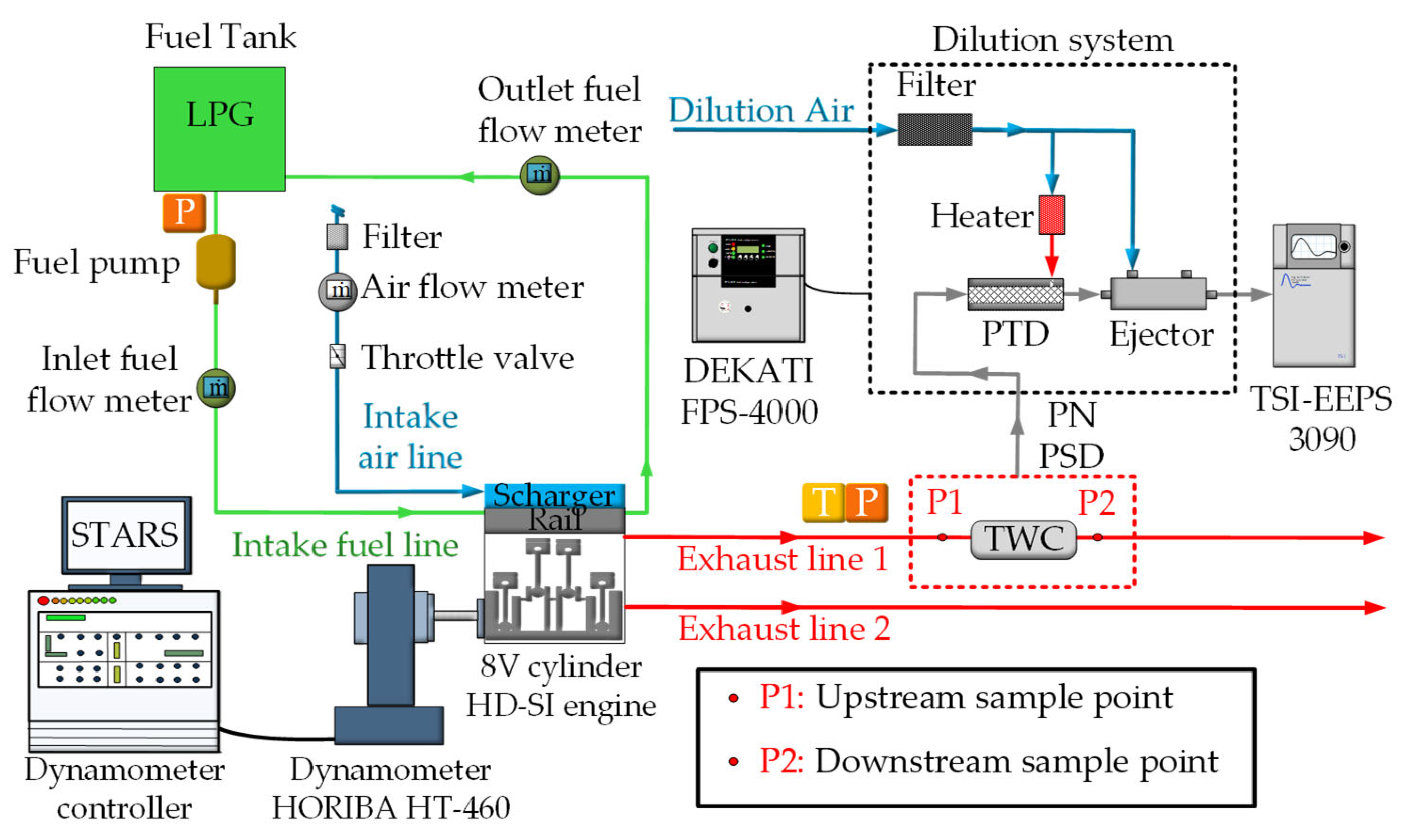
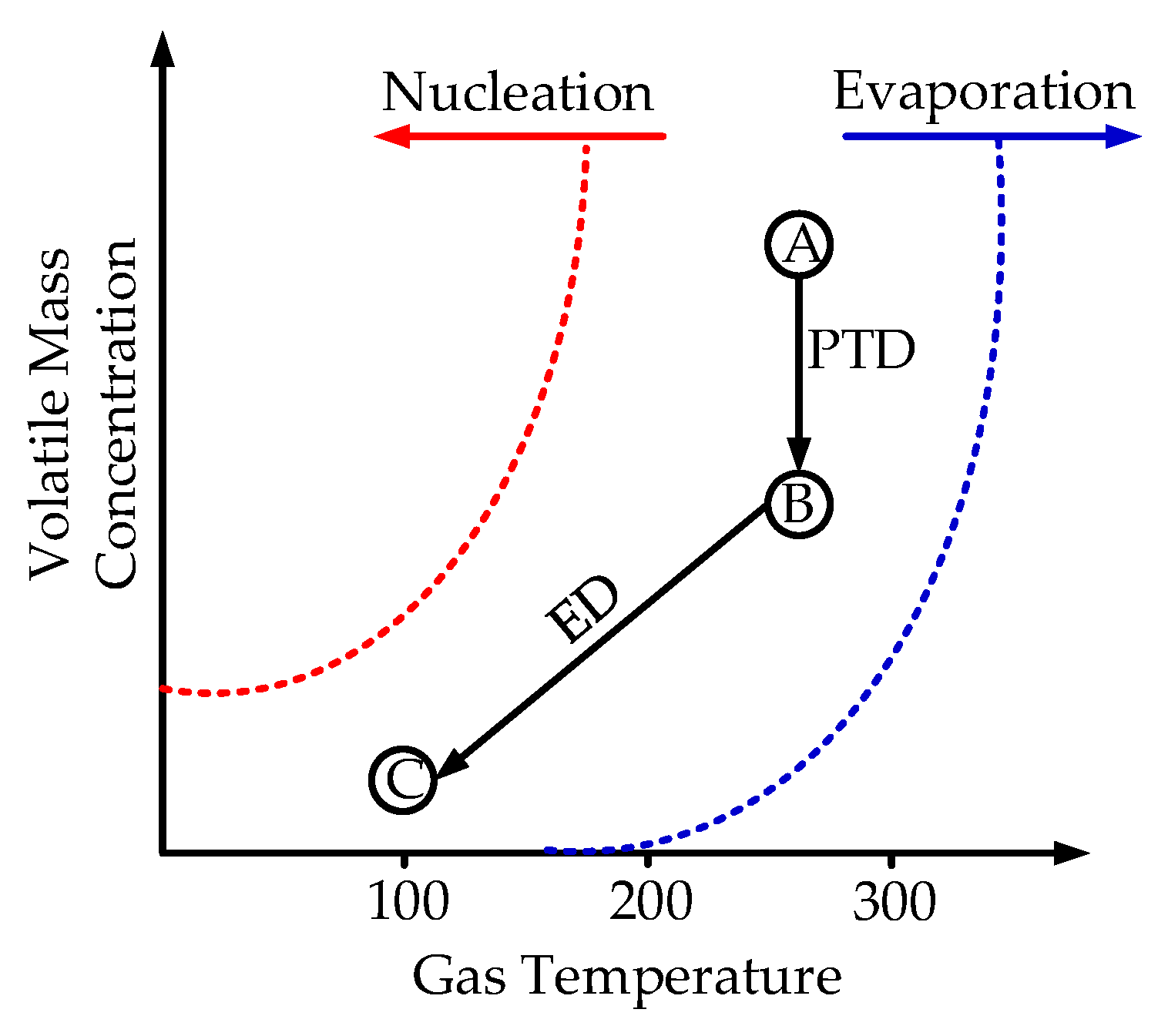


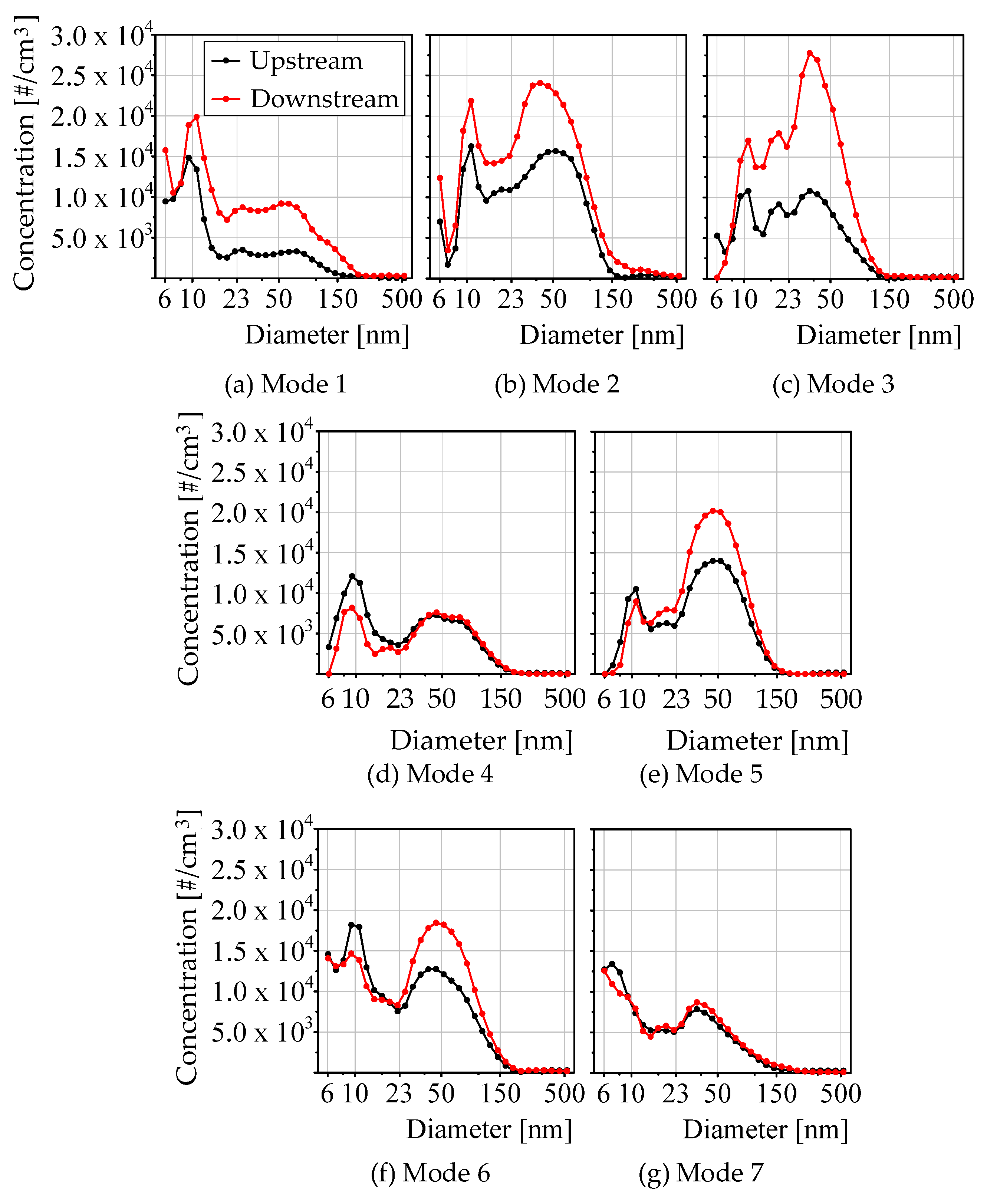
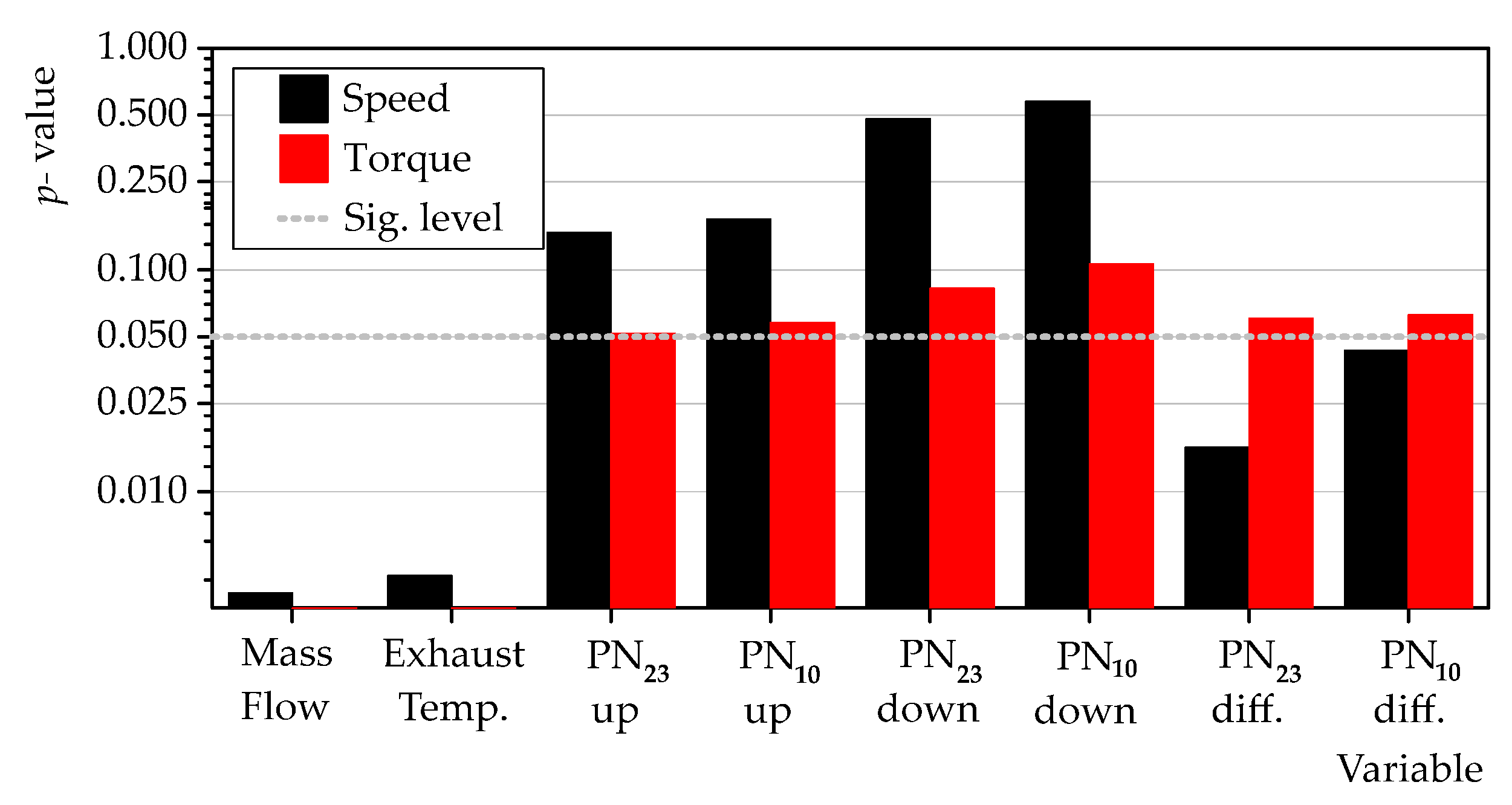

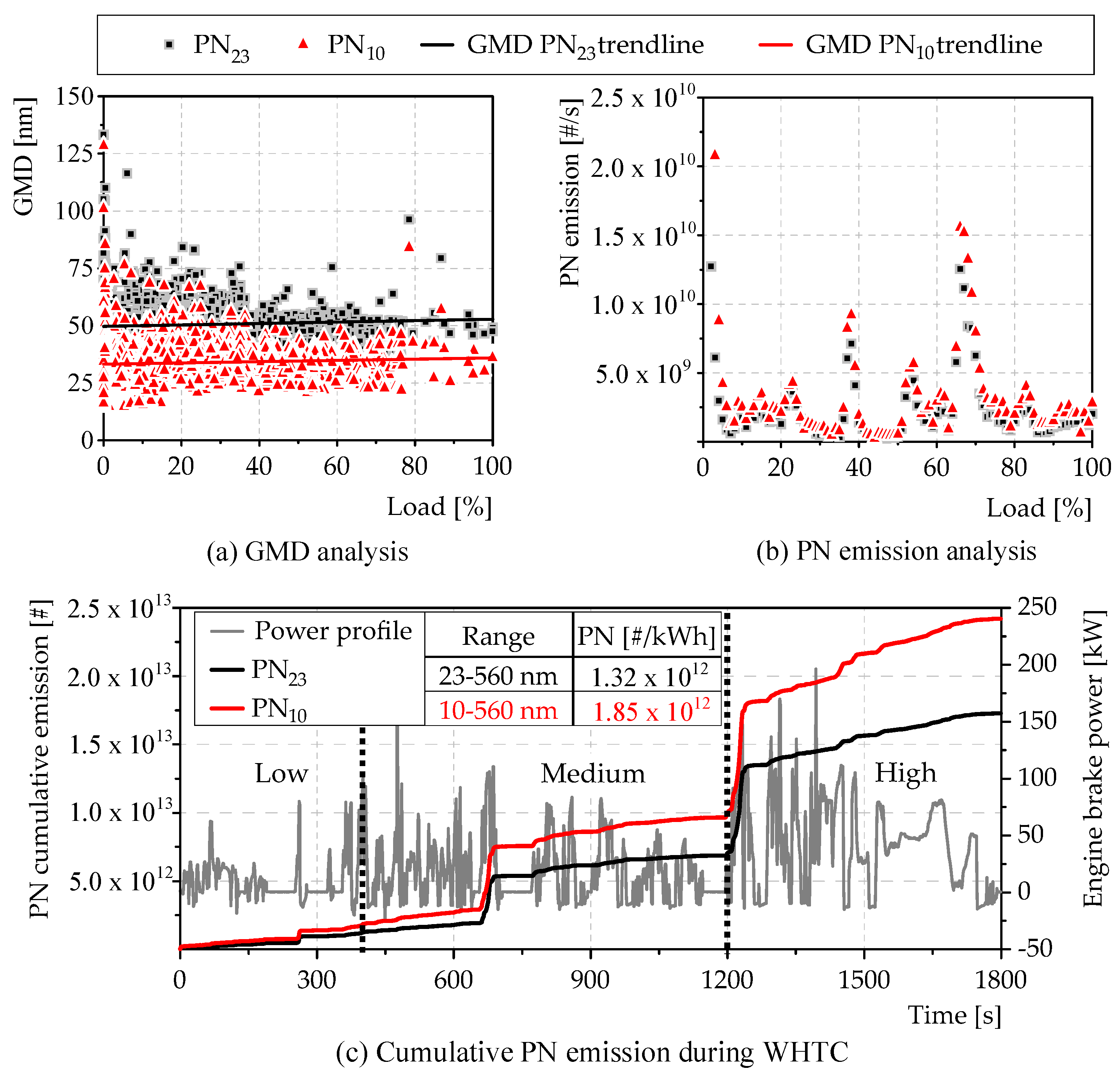
| Characteristic | Value |
|---|---|
| Style | 4-stroke, HD-SI Engine |
| Emission standard | EURO VI |
| Maximum power | 221 kW@2250 rpm |
| Maximum brake torque | 1070 Nm@1890 rpm |
| Maximum injection | 12 bar |
| Injector type | Peak and Hold |
| Number of valves per cylinder | 2 |
| Total displaced volume | 7200 cm3 |
| Number of cylinders | 8 |
| Compression ratio | 11.2:1 |
| TWC length | 0.1438 m |
| TWC diameter | 0.1524 |
| TWC volume | 0.002262 m3 |
| TWC cell density | 600 cpsi |
| Characteristic | Value |
|---|---|
| C2 content | 0.53% v/v |
| C3 content | 93.62% v/v |
| C4 content | 5.82% v/v |
| C5 content | 0.03% v/v |
| Density (T = 15 °C) | 511.05 kg/m3 |
| Density (T = 50 °C) | 454.59 kg/m3 |
| Viscosity (T = 20 °C) | 78.96 μP |
| Air to fuel ratio (AFR) | 15.42 |
| Vaporization temperature | −37 °C |
| Lower heating value | 45.86 MJ/kg |
| Research octane number (RON) | 110.35 |
| Magnitude | Sensor/Instrument | Range | Sensitivity |
|---|---|---|---|
| Mean pressure | Piezoelectric sensor | 0–70 bar | ±1 [%] |
| Air mass flow | AVL Flowsonix Air | 0 ± 2400 kg/h | ±1 [%] |
| Fuel mass flow | Emerson Coriolis | 0–2180 kg/h | ±0.35 [%] |
| Temperature | Thermocouple Type K | −200–1, 2000 °C | ±2.5 [°C] |
| Torque | Torquimeter HBM T40 | 0–2000 Nm | ±0.05 [%] |
| PN and PSD | TSI-EEPS | 5.6 nm: 108 #/cm3 560 nm: 106 #/cm3 | ±5% actual value |
Disclaimer/Publisher’s Note: The statements, opinions and data contained in all publications are solely those of the individual author(s) and contributor(s) and not of MDPI and/or the editor(s). MDPI and/or the editor(s) disclaim responsibility for any injury to people or property resulting from any ideas, methods, instructions or products referred to in the content. |
© 2024 by the authors. Licensee MDPI, Basel, Switzerland. This article is an open access article distributed under the terms and conditions of the Creative Commons Attribution (CC BY) license (https://creativecommons.org/licenses/by/4.0/).
Share and Cite
Bermúdez, V.; Piqueras, P.; Sanchis, E.J.; Conde, B. Analysis of Particle Number Emissions in a Retrofitted Heavy-Duty Spark Ignition Engine Powered by LPG. Atmosphere 2024, 15, 704. https://doi.org/10.3390/atmos15060704
Bermúdez V, Piqueras P, Sanchis EJ, Conde B. Analysis of Particle Number Emissions in a Retrofitted Heavy-Duty Spark Ignition Engine Powered by LPG. Atmosphere. 2024; 15(6):704. https://doi.org/10.3390/atmos15060704
Chicago/Turabian StyleBermúdez, Vicente, Pedro Piqueras, Enrique José Sanchis, and Brayan Conde. 2024. "Analysis of Particle Number Emissions in a Retrofitted Heavy-Duty Spark Ignition Engine Powered by LPG" Atmosphere 15, no. 6: 704. https://doi.org/10.3390/atmos15060704





